8 Sea Vegetables You Can Cook With
A guide to umami-rich seaweeds, algae and other edible plants of the sea.
8 Sea Vegetables You Can Cook With
A guide to umami-rich seaweeds, algae and other edible plants of the sea.
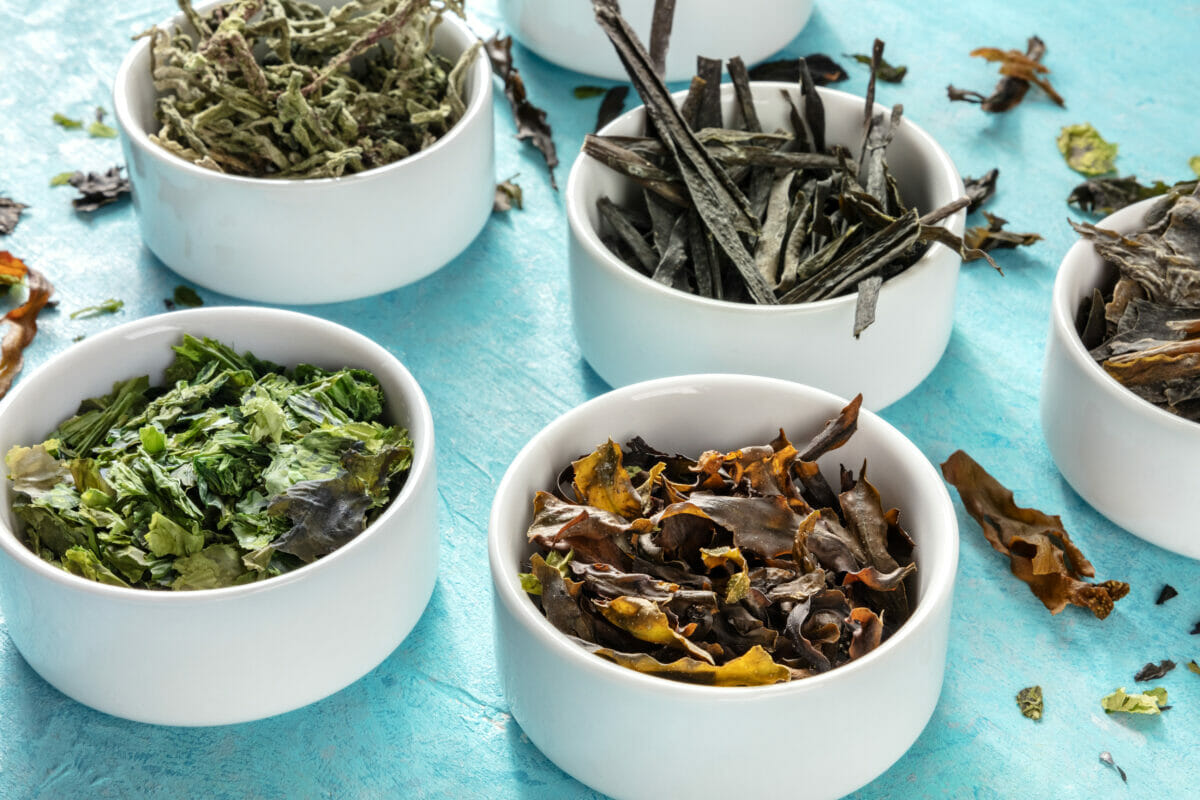
Ocean-sourced produce could soon dominate our food future.by Cook Shoots Food, Shutterstock.
Whoever said your leafy greens needed to be sourced only from the soil?
Although they’re a longtime staple of many Asian cuisines, sea vegetables have been increasing in popularity in other parts of the world, becoming more prominent on restaurant menus and in home kitchens. Renowned chefs such as Enda McEvoy of Loam in the UK and Dan Barber of Blue Hill in New York have been utilizing seaweed in their dishes. Companies such as Blue Evolution have created products such as kelp popcorn and seaweed pasta, while meat alternative brand Akua recently introduced a kelp burger.
And there are a lot of signs pointing to the fact that sea vegetables could become a key part of our diets in the near future. Earlier this year, Modern Farmer reported on underwater kelp gardens becoming a centerpiece of ocean farming to pave the way for a more sustainable future.
In general, sea vegetables are full of vitamins and minerals such as potassium, iron, calcium, fiber, iodine and amino acids. They also have the ability to soak up to five times more carbon than land-based plants. And with micro nutrients declining in soils due to factory farming and climate change, plants that grow in the ocean could become a more reliable option for produce.
For some interested in this trend, however, drifting into unfamiliar food territory can feel overwhelming. Not to worry. Here’s a list of eight plants from the sea with everything you need to know about them.
As you mull through the following choices, please note that we have selected vegetables you can easily find at Asian markets, your local grocer or health food store, as well as larger retailers. Sea vegetables are most commonly sold in dried form, but they are easy to rehydrate and work with.
Kombu
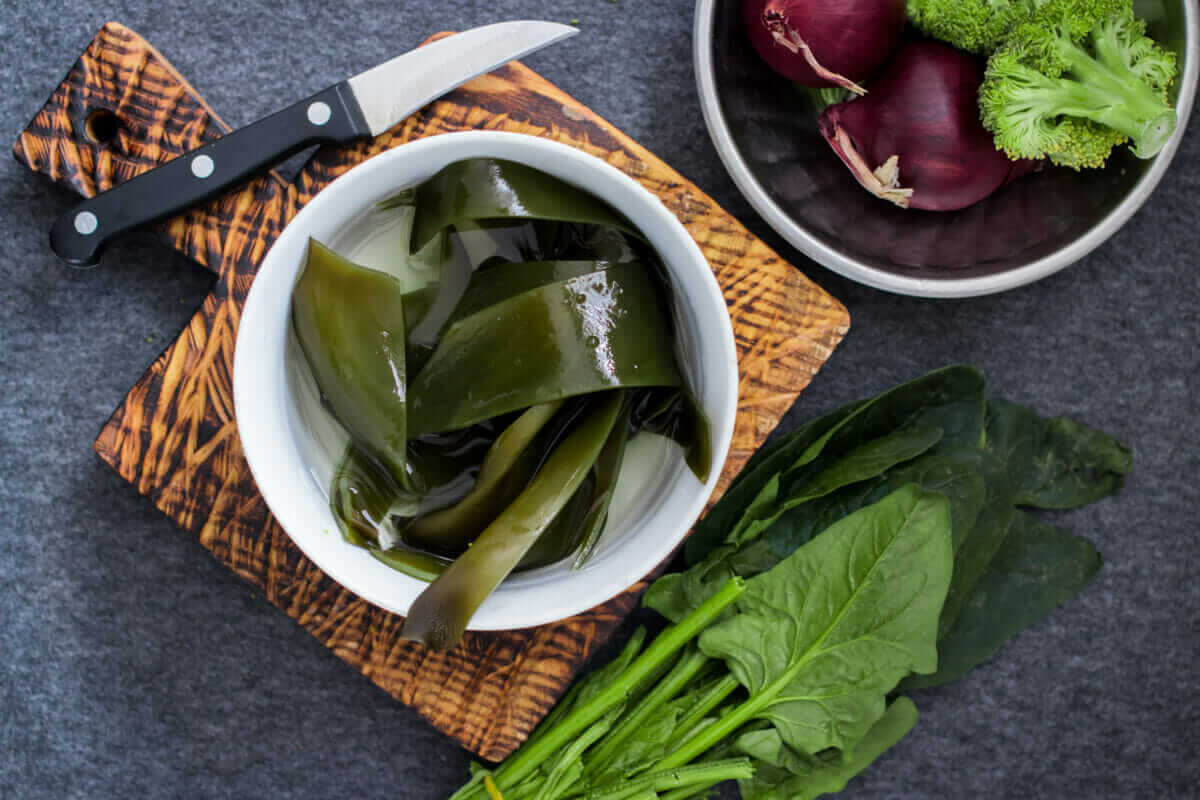
Kombu is a Japanese version of kelp that grows on the coasts of Japan, Russia, China, Tasmania, Australia, South Africa and the Scandinavian Peninsula as well as western regions of North America such as California and British Columbia.
This slippery sea vegetable has been described as having a briny, mushroom-like umami flavor, but it is tougher and thicker than many other types of seaweeds. Kombu is best known for being a staple ingredient in the Japanese soup stock, dashi. We suggest adding it to soups or stews, as seen in this kombu chicken soup with carrots and mushrooms or this creamy white bean stew with parmesan. It can also be pickled, dried or consumed fresh in a salad.
Wakame
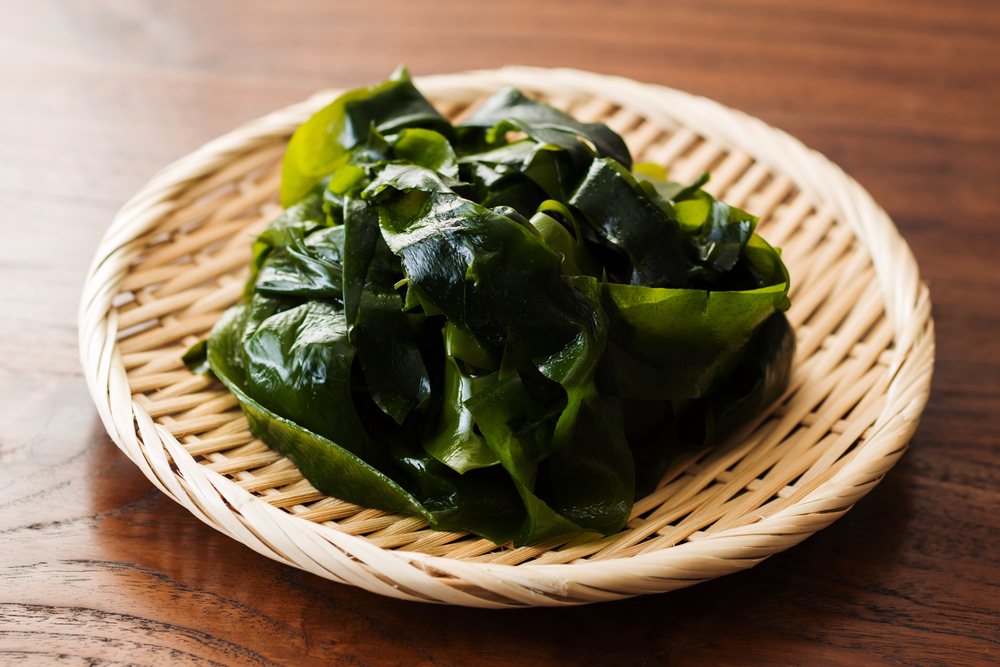
Meet wakame, a type of algae native to coastal Japan, China, Korea and Russia. It is also found in cold temperate areas of the Northwest Pacific ocean.
This plant, also known as sea mustard, is recognized for its silky smooth texture and umami flavor that has a slight sweetness. It’s commonly used in miso soup. It can also be used in curries as a base, as seen in this tofu yellow curry. But because of its delicate texture, wakame pairs well in salads with ingredients that have a bit more crunch, such as this vegan cucumber salad or this confetti salad with black sesame dressing.
Wakame is typically sold in stores in a dehydrated form. You can revive it by soaking it in a dish of warm water for 10 to 15 minutes. And if you have only made a small dent in the package you have bought, no need to worry because dehydrated seaweed can keep for a number of years.
Arame

Arame is a long, wiry, dark brown kelp that is native to temperate climates around the Pacific Ocean. Typically, it is sourced from the shores of Shima in Japan. It has a sweet, mild flavor and is tender in texture. Because of this, it is one of the more versatile seaweeds that can be used in a variety of recipes such as this brown rice dish with vegetables, this spicy tahini sauce and soba noodles stir fry or this arame pasta minestrone.
Like wakame, it is usually sold dehydrated. To restore it, place it in warm water for five to 10 minutes.
Dulse
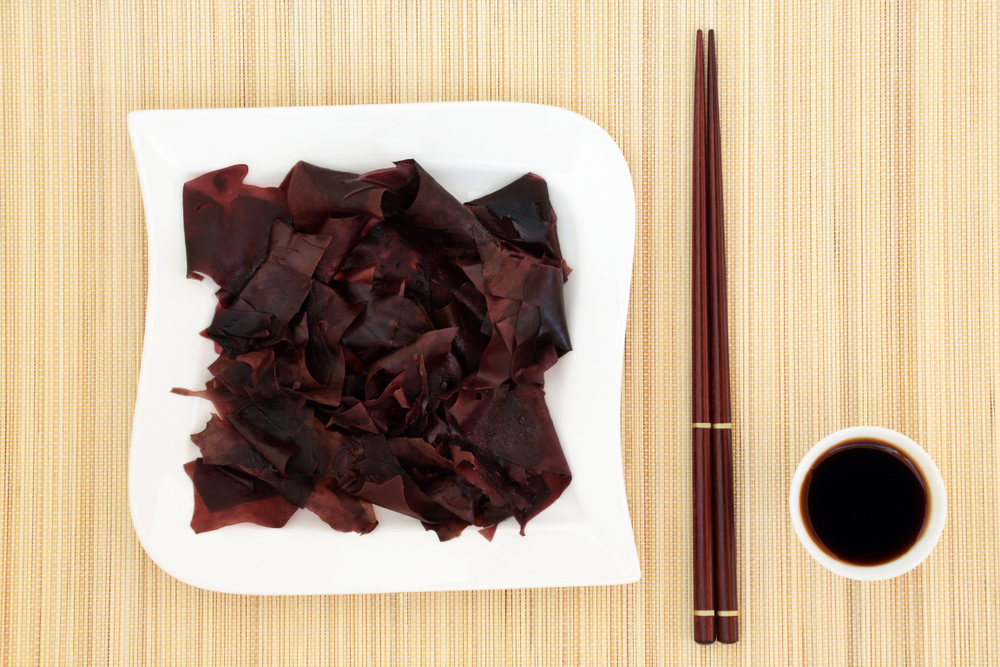
Dulse is a type of seaweed, recognized by its ruddy, red to dark purple coloring. It largely grows along the northern rocky coasts of the Atlantic, Pacific and Arctic oceans. However, it has been popping up in warmer temperate areas as far south as New Jersey in North America and along the coastal regions of Portugal and Spain.
This vibrant ocean crop has a soft, leathery texture and has been described as having a salty, savory taste similar to bacon. We recommend using it as a burst of flavor in dishes as a meat seasoning or meat substitute—whether you’re vegetarian or not.
Like the other seaweed crops, it can be an ideal addition to soups, salads or stews. It can also be fried up in oil and enjoyed as a healthy chip alternative. This recipe for parmesan dulse crisps is a good starting point. If you’re in the mood for further experimentation, you can add them to scones.
Dulse is sold fresh, dehydrated, in stripes, flakes and even in powders (often used as an additive to smoothies).
Nori
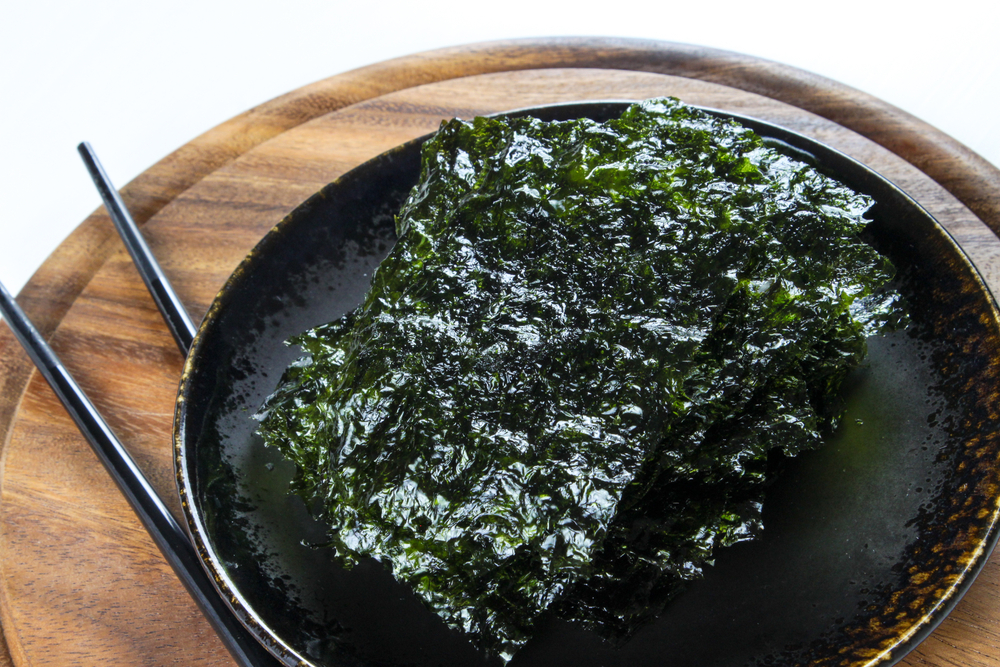
You likely know nori as the deep green piece of seaweed that holds your sushi rolls together. It’s slightly sweet and nutty in flavor. Although it grows wild in cold coastal areas around Japan and the British Isles, commercial production has been prevalent in Washington and British Columbia over the last few decades.
Nori is sold in crispy sheets, either plain or toasted. If you’d like to try to use this vegetable in something other than sushi, you can use it as a garnish on top of salads, rice bowls or soups for an extra burst of umami. And, like dulse, nori makes a tasty snack when roasted as chips. More creative uses could consist of using it as a central ingredient in dips, as seen in this nori sour cream variation. You can also wrap them in a meat or meat alternative and fry them up. These deep fried nori-wrapped tofu or nori-crusted steaks are two starting points.
Carrageen Moss
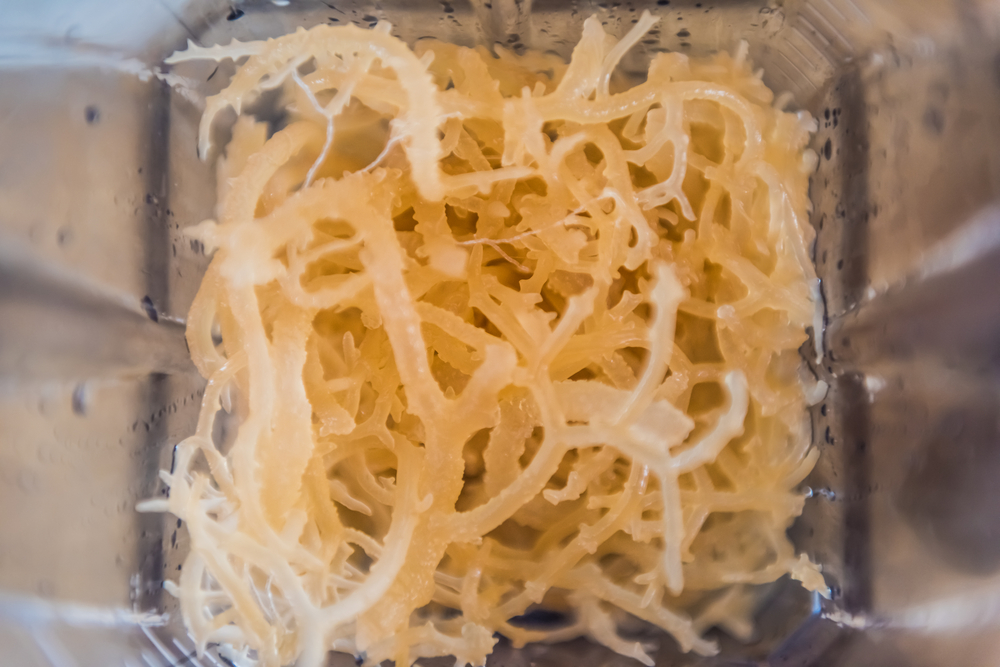
Carrageen moss, also known as Irish moss, is a type of algae that spawns on the Atlantic’s shorelines of North America and Europe. This plant—tree-like in appearance with its tiny branches—grows in shades of purple, red, green, yellow, brown and black.
When consumed raw, it has been described as having an earthy, fishy taste, comparable to that of oysters and clams. Despite this, it is generally utilized as a healthy thickener for smoothies and desserts such as tapioca and ice cream. If it is not being used in a powdered form, when raw, Irish moss can be made into a thickener by boiling or soaking it in its raw form. This also rids the plant of its fishy flavor.
Here are some recipes for Irish moss pudding and Irish moss smoothie to inspire you.
Salicornia

Salicornia, commonly called sea beans or asparagus of the sea, is a succulent that grows in salty tidal pools, marshes and mangroves. It can be found in North America, South Africa, South Asia and parts of the UK.
These snappy green stalks are a crispy, crunchy and naturally salty addition to any meal. They can be consumed raw or cooked. Their brininess pairs well with other seafoods, as seen in this mussel and sea bean salad or this recipe with daikon and salmon. Alternatively, salicornia can be pickled or cooked on its own with garlic, olive oil, lemon juice and onion. One word of caution, however, would be to avoid pairing this vegetable with other salty ingredients.
Unlike the other sea vegetables provided on this list, Salicornia can be a bit more difficult to find. Look for it at your local farmers’ market during peak season from May to September, at specialty wild food stores or Whole Foods.
Ulva Lactuca

Ulva lactuca, otherwise known as sea lettuce, is a type of green algae that grows in intertidal and subtidal areas around Europe, North America, Central America, the Caribbean Islands, South America, Southwest Asia, Australia and New Zealand.
Sea lettuce, unsurprisingly, adds a briny flavor to recipes. When fresh or hydrated, it is crunchy and has a smooth, slimy texture. In its dehydrated state, it is light and flaky. Like the other seaweeds, it can be recovered to its natural state by soaking it in warm water for up to 15 minutes.
There are a number of ways sea lettuce can be consumed. Swap your regular lettuce for this ocean alternative. You can also use it as the base in a poké bowl, a crust for cooked salmon or an additive in potato leek soup for more umami flavor. When minced, sea lettuce can also be substituted for salt.
Follow us
This work is licensed under a Creative Commons Attribution-NoDerivatives 4.0 International License.
Want to republish a Modern Farmer story?
We are happy for Modern Farmer stories to be shared, and encourage you to republish our articles for your audience. When doing so, we ask that you follow these guidelines:
Please credit us and our writers
For the author byline, please use “Author Name, Modern Farmer.” At the top of our stories, if on the web, please include this text and link: “This story was originally published by Modern Farmer.”
Please make sure to include a link back to either our home page or the article URL.
At the bottom of the story, please include the following text:
“Modern Farmer is a nonprofit initiative dedicated to raising awareness and catalyzing action at the intersection of food, agriculture, and society. Read more at <link>Modern Farmer</link>.”
Use our widget
We’d like to be able to track our stories, so we ask that if you republish our content, you do so using our widget (located on the left hand side of the article). The HTML code has a built-in tracker that tells us the data and domain where the story was published, as well as view counts.
Check the image requirements
It’s your responsibility to confirm you're licensed to republish images in our articles. Some images, such as those from commercial providers, don't allow their images to be republished without permission or payment. Copyright terms are generally listed in the image caption and attribution. You are welcome to omit our images or substitute with your own. Charts and interactive graphics follow the same rules.
Don’t change too much. Or, ask us first.
Articles must be republished in their entirety. It’s okay to change references to time (“today” to “yesterday”) or location (“Iowa City, IA” to “here”). But please keep everything else the same.
If you feel strongly that a more material edit needs to be made, get in touch with us at [email protected]. We’re happy to discuss it with the original author, but we must have prior approval for changes before publication.
Special cases
Extracts. You may run the first few lines or paragraphs of the article and then say: “Read the full article at Modern Farmer” with a link back to the original article.
Quotes. You may quote authors provided you include a link back to the article URL.
Translations. These require writer approval. To inquire about translation of a Modern Farmer article, contact us at [email protected]
Signed consent / copyright release forms. These are not required, provided you are following these guidelines.
Print. Articles can be republished in print under these same rules, with the exception that you do not need to include the links.
Tag us
When sharing the story on social media, please tag us using the following: - Twitter (@ModFarm) - Facebook (@ModernFarmerMedia) - Instagram (@modfarm)
Use our content respectfully
Modern Farmer is a nonprofit and as such we share our content for free and in good faith in order to reach new audiences. Respectfully,
No selling ads against our stories. It’s okay to put our stories on pages with ads.
Don’t republish our material wholesale, or automatically; you need to select stories to be republished individually.
You have no rights to sell, license, syndicate, or otherwise represent yourself as the authorized owner of our material to any third parties. This means that you cannot actively publish or submit our work for syndication to third party platforms or apps like Apple News or Google News. We understand that publishers cannot fully control when certain third parties automatically summarize or crawl content from publishers’ own sites.
Keep in touch
We want to hear from you if you love Modern Farmer content, have a collaboration idea, or anything else to share. As a nonprofit outlet, we work in service of our community and are always open to comments, feedback, and ideas. Contact us at [email protected].by Lindsay Campbell, Modern Farmer
October 2, 2021
Modern Farmer Weekly
Solutions Hub
Innovations, ideas and inspiration. Actionable solutions for a resilient food system.
ExploreExplore other topics
Share With Us
We want to hear from Modern Farmer readers who have thoughtful commentary, actionable solutions, or helpful ideas to share.
SubmitNecessary cookies are absolutely essential for the website to function properly. This category only includes cookies that ensures basic functionalities and security features of the website. These cookies do not store any personal information.
Any cookies that may not be particularly necessary for the website to function and are used specifically to collect user personal data via analytics, ads, other embedded contents are termed as non-necessary cookies.
Very interesting!